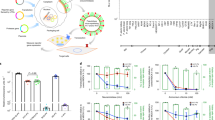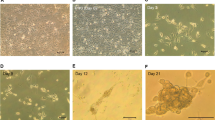Abstract
Here, we developed hCK, a Madin-Darby canine kidney (MDCK) cell line that expresses high levels of human influenza virus receptors and low levels of avian virus receptors. hCK cells supported human A/H3N2 influenza virus isolation and growth much more effectively than conventional MDCK or human virus receptor-overexpressing (AX4) cells. A/H3N2 viruses propagated in hCK cells also maintained higher genetic stability than those propagated in MDCK and AX4 cells.
This is a preview of subscription content, access via your institution
Access options
Access Nature and 54 other Nature Portfolio journals
Get Nature+, our best-value online-access subscription
$29.99 / 30 days
cancel any time
Subscribe to this journal
Receive 12 digital issues and online access to articles
$119.00 per year
only $9.92 per issue
Buy this article
- Purchase on Springer Link
- Instant access to full article PDF
Prices may be subject to local taxes which are calculated during checkout

Similar content being viewed by others
Data availability
The data that support the findings of this study are available from the corresponding authors on request. DNA sequencing data from this study are available under the NCBI BioProject accession number PRJNA525907.
References
Gamblin, S. J. & Skehel, J. J. J. Biol. Chem. 285, 28403–28409 (2010).
Chambers, B. S., Li, Y., Hodinka, R. L. & Hensley, S. E. J. Virol. 88, 10986–10989 (2014).
Lee, H. K. et al. PLoS ONE 8, e79252 (2013).
Tamura, D. et al. Antimicrob. Agents Chemother. 57, 6141–6146 (2013).
Lin, Y. et al. Influenza Other Respir. Viruses 11, 263–274 (2017).
Li, D. et al. J. Clin. Microbiol. 47, 466–468 (2009).
Oh, D. Y., Barr, I. G., Mosse, J. A. & Laurie, K. L. J. Clin. Microbiol. 46, 2189–2194 (2008).
Mohr, P. G., Deng, Y. M. & McKimm-Breschkin, J. L. Virol. J. 12, 67 (2015).
Lin, Y. P. et al. J. Virol. 84, 6769–6781 (2010).
Zhu, X. et al. J. Virol. 86, 13371–13383 (2012).
Connor, R. J., Kawaoka, Y., Webster, R. G. & Paulson, J. C. Virology 205, 17–23 (1994).
Rogers, G. N. & Paulson, J. C. Virology 127, 361–373 (1983).
Stevens, J. et al. J. Mol. Biol. 355, 1143–1155 (2006).
Lin, S. C., Kappes, M. A., Chen, M. C., Lin, C. C. & Wang, T. T. PLoS ONE 12, e0172299 (2017).
Hatakeyama, S. et al. J. Clin. Microbiol. 43, 4139–4146 (2005).
Matrosovich, M., Matrosovich, T., Carr, J., Roberts, N. A. & Klenk, H. D. J. Virol. 77, 8418–8425 (2003).
van Riel, D. et al. Science 312, 399 (2006).
Shinya, K. et al. Nature 440, 435–436 (2006).
Cong, L. et al. Science 339, 819–823 (2013).
Jinek, M. et al. Science 337, 816–821 (2012).
Han, J. et al. Cell Rep. 23, 596–607 (2018).
Shalem, O. et al. Science 343, 84–87 (2014).
Takashima, S. & Tsuji, S. Trends Glycosci. Glycotechnol. 23, 178–193 (2011).
Chu, V. C. & Whittaker, G. R. Proc. Natl Acad. Sci. USA 101, 18153–18158 (2004).
Hidari, K. I. et al. Biochem. Biophys. Res. Commun. 436, 394–399 (2013).
Shibuya, N. et al. J. Biochem. 106, 1098–1103 (1989).
Chambers, B. S., Parkhouse, K., Ross, T. M., Alby, K. & Hensley, S. E. Cell Rep. 12, 1–6 (2015).
Skowronski, D. M. et al. Euro Surveill. 21, 30112 (2016).
Saito, T. et al. J. Med. Virol. 74, 336–343 (2004).
Lenth, R. V. J. Stat. Softw. 69, 1–33 (2016).
Bates, D., Machler, M., Bolker, B. M. & Walker, S. C. J. Stat. Softw. 67, 1–48 (2015).
Acknowledgements
We thank S. Watson for scientific editing. We also thank N. Midorikawa for technical assistance. In addition, we thank E. Adachi, T. Koibuchi, T. Kikuchi, M. Koga, H. Yotsuyanagi, A. Tokita and N. Wada for providing us with the clinical specimens from patients with influenza-like symptoms. Flow cytometry was performed in the IMSUT FACS Core laboratory; we acknowledge the IMSUT FACS Core laboratory for assistance with the flow cytometric analysis. This research was supported by Leading Advanced Projects for medical innovation (LEAP) from the Japan Agency for Medical Research and Development (AMED) (JP18am001007), by Grants-in-Aid for Scientific Research on Innovative Areas from the Ministry of Education, Culture, Science, Sports, and Technology (MEXT) of Japan (nos. 16H06429, 16K21723 and 16H06434), by the Japan Initiative for Global Research Network on Infectious Diseases (J-GRID) from AMED (JP18fm0108006), by an e-ASIA Joint Research Program from AMED (JP17jm0210042), by a Research Program on Emerging and Re-emerging Infectious Diseases from AMED (JP18fk0108104), by a Grant-in-Aid for JSPS Research Fellows (17J04123) and by the NIAID-funded Center for Research on Influenza Pathogenesis (CRIP; HHSN272201400008C).
Author information
Authors and Affiliations
Contributions
K.T., C.K., S.F., S.C., G.Z., C.G., K.S., S.T., Y.S.-T., J.D., Z.K., D.K., H.v.B., S.Y. and M.I. performed the experiments. K.T., C.K., S.F., S.T., T.J.S.L., T.W., M.I. and Y.K. planned the experiments and/or analysed the data. K.T., T.J.S.L., M.I. and Y.K. wrote the manuscript.
Corresponding authors
Ethics declarations
Competing interests
K.T., C.K., S.F., S.C., G.Z., C.G., K.S., S.T., T.J.S.L., J.D., Z.K., D.K., H.v.B., Y.S.-T., S.Y., T.W. and M.I. declare no competing interests. Y.K. has received speaker’s honoraria from Toyama Chemical and Astellas and grant support from Chugai Pharmaceuticals, Daiichi Sankyo Pharmaceutical, Toyama Chemical, Tauns Laboratories and Otsuka Pharmaceutical, and is a founder of FluGen.
Additional information
Publisher’s note: Springer Nature remains neutral with regard to jurisdictional claims in published maps and institutional affiliations.
Supplementary information
Supplementary Information
Supplementary Data and Discussion, Supplementary Methods, Supplementary Figures 1–3, Supplementary Tables 1–8 and Supplementary References.
Rights and permissions
About this article
Cite this article
Takada, K., Kawakami, C., Fan, S. et al. A humanized MDCK cell line for the efficient isolation and propagation of human influenza viruses. Nat Microbiol 4, 1268–1273 (2019). https://doi.org/10.1038/s41564-019-0433-6
Received:
Accepted:
Published:
Issue Date:
DOI: https://doi.org/10.1038/s41564-019-0433-6
This article is cited by
-
Predictive evolutionary modelling for influenza virus by site-based dynamics of mutations
Nature Communications (2024)
-
Glyco-engineered MDCK cells display preferred receptors of H3N2 influenza absent in eggs used for vaccines
Nature Communications (2023)
-
Safety and immunogenicity of a phase 1/2 randomized clinical trial of a quadrivalent, mRNA-based seasonal influenza vaccine (mRNA-1010) in healthy adults: interim analysis
Nature Communications (2023)
-
A broadly protective human monoclonal antibody targeting the sialidase activity of influenza A and B virus neuraminidases
Nature Communications (2022)
-
Sialylated and sulfated N-Glycans in MDCK and engineered MDCK cells for influenza virus studies
Scientific Reports (2022)



